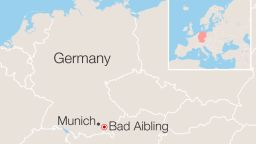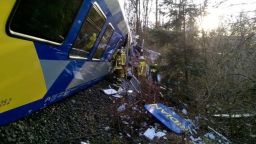Story highlights
Eleven people died, dozens injured in last week's crash in German state of Bavaria
A 39-year-old dispatcher was responsible, a prosecutor says
Human error caused last week’s deadly head-on collision of two trains in the southern German state of Bavaria, a local prosecutor said Tuesday.
Senior prosecutor Wolfgang Giese said a 39-year-old dispatcher was responsible for the crash that killed 11 people and injured dozens more.
“If he had complied with the rules … then there would have been no collision between the trains,” Giese said.

The unnamed dispatcher signaled for the two trains coming from opposite directions to travel on a single track. Prosecutors believe that the event was a “mistake” and have opened an involuntary manslaughter case against the dispatcher.
He was extensively interrogated Monday and delivered a detailed statement about what happened on the day of the crash, authorities said. Investigators are also interviewing passengers and staff members and have found no evidence of mechanical failure or technical defects as causes for the crash, they said.
Crash called ‘one of the biggest we have had’
The crash occurred shortly before 7 a.m. February 9 near the spa town of Bad Aibling, about 60 kilometers (37 miles) southeast of the Bavarian capital of Munich. Police have said at least 24 people suffered severe injuries and another 61 had less serious injuries.
They said there were about 150 passengers on board the two trains. Both train drivers died in the crash.

The trains collided at a bend on the Mangfall Valley Railway, a single-track regional rail line between the towns of Rosenheim and Holzkirchen, German Transport Minister Alexander Dobrindt said.
“There’s a curve there, so we must assume that the train drivers must not have been able to see each other beforehand,” Dobrindt told reporters last week at a news conference.
One of the trains had “drilled” into the other, he said, leaving a carriage “totally dismantled.”
He described the scene as a “horrible picture,” saying it was estimated the trains had been traveling about 100 kilometers per hour (62 mph) at the moment of impact.
“This is a difficult hour for the railways in Germany,” Dobrindt said, describing the crash as “one of the biggest we have had for years.
“We cannot imagine that such an accident can happen here,” he said.
Railway had automatic braking system
Authorities said the railway was equipped with an automatic braking system that would stop trains from running on a track where they were not supposed to be.
The safety system was implemented across Germany’s railways after a 2011 crash in the town of Oschersleben that killed 10 people, Dobrindt said.
Each train in last week’s crash had both a driver and a driver instructor on board, said Christian Schreyer, board chairman for Transdev, the parent company of train operator Meridian. It would be extremely unlikely for both the driver and driver instructor on a train to miss a red signal – and then for the automatic braking system not to kick in, he said.
Bavarian Interior Minister Joachim Herrmann has said at least one of the trains was not running to schedule. “Why they did not stick to the timetable, we don’t know. This has to be investigated,” he said.
More than 600 police and rescue workers scrambled to the crash scene in the hilly, forested region. Dobrindt said police were there within minutes of the crash.
Helicopters and boats ferried the injured to hospitals and clinics. Authorities said it took about three hours to remove the victims.







